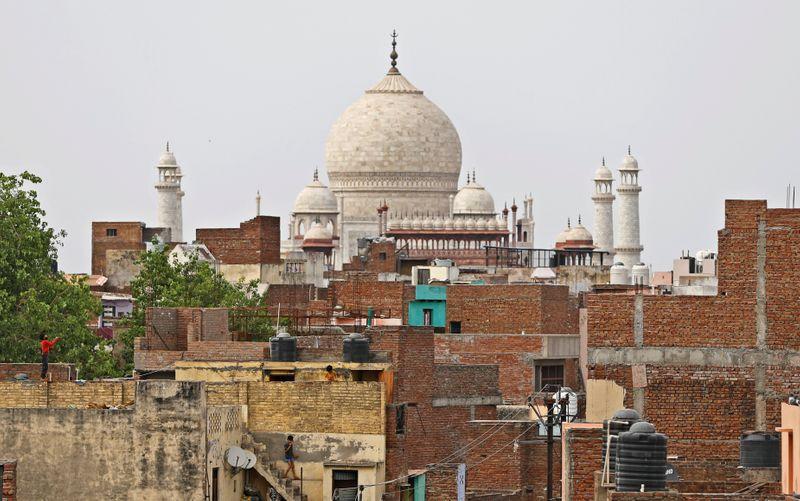Covid-19 Resurgence Carries Warning Signs In Agra
May 4, 2020 | Pratirodh Bureau
Children play on the roof of their houses as the historic Taj Mahal is seen in the background during a nationwide lockdown to slow the spread of the coronavirus disease in Agra on April 23, 2020
On Feb. 25, a day after U.S. President Donald Trump and his wife Melania posed for pictures outside the Taj Mahal on an official visit to India, Sumit Kapoor returned to his nearby home from a trip to Italy.
Kapoor, a partner in a shoe manufacturing firm, tested positive a week later for the new coronavirus, becoming the first confirmed case in Agra and the origin of the country’s first big cluster of the virus.
The city of 1.6 million people, famous for its 17th-century marble-domed Taj Mahal, moved fast. It set up containment zones, screened hundreds of thousands of residents and conducted widespread contact tracing.
By early April, the city thought it had the virus beat, containing cases to under 50, while new infections exploded in other Indian cities. Prime Minister Narendra Modi’s government lauded the “Agra Model” as a template for the country’s battle against COVID-19, the disease caused by the coronavirus.
Now, as the city and its hospitals battle a second wave of infections, Agra is a model of a different kind, illustrating how the coronavirus can roar back even after a swift lockdown and elaborate containment measures.
“If it hadn’t spread in the hospitals, we would have been able to contain it,” said Agra’s top local official, District Magistrate Prabhu N. Singh.
As India grapples with around 42,000 coronavirus infections, second only to China in Asia, Agra’s tangle with the virus offers lessons for big cities in India and elsewhere.
It all began with a shoemaker who visited a trade fair in Italy.
After flying home via Austria, Kapoor, 44, who lives about 10 kilometres away from the Taj Mahal, first learned he might be infected on March 1, when his brother-in-law who travelled with him came down with a fever and tested positive in New Delhi. A state official called Kapoor the next day and told him to get tested at the Agra District Hospital.
He was positive – and so were his father, mother, son, wife and brother. All six were moved to a hospital in New Delhi. “My brother and I had a sore throat and the other four didn’t have any symptoms,” Kapoor told Reuters.
Later, Kapoor’s accountant in Agra and his wife also tested positive for COVID-19, while other unrelated cases started showing up around the city.
CONTAINMENT ZONES & LOUDSPEAKERS
Singh, the district magistrate, and his team attempted to establish containment zones as the virus spread across the city, but they ran into a problem: how to quickly screen thousands of households.
Dr. Brajendra Singh Chandel, a surveillance medical officer with the World Health Organization in Agra, said he pulled out vaccination “microplans” that had been developed for polio control by the WHO, using them alongside Google Maps to plot target areas.
The detailed household-level plans, which helped India eradicate polio in 2014, have clearly demarcated starting, middle and end points for surveying an area, Chandel explained, allowing teams to work their way through any neighbourhood efficiently.
“Once we zeroed down on the area, we used the polio microplans to execute,” he said.
Local authorities identified an epicentre for each cluster of infections and drew three-kilometre-wide containment zones around them. They surveyed residents in those areas, looking for those who had contact with people who tested positive for the coronavirus or who were showing symptoms. Nearly 3,000 workers screened some 165,000 households, according to a government presentation.
Meanwhile, epidemiologists from the federal government’s India Epidemic Intelligence Service arrived in Agra to help with containment, contact tracing and analysing data, said Dr Anshul Pareek, who leads the city’s coronavirus rapid response team.
As the number of cases grew, authorities sealed off infection hotspots – typically groups of houses or parts of a street – and cordoned off adjoining neighbourhoods holding as many as 10,000 people. In a control room used to manage traffic, officials monitored camera feeds from across the city to ensure the lockdown was enforced. Thousands of police were deployed to hotspots and checkpoints. Loudspeakers blared messages telling residents to stay indoors.
That differed from other Indian cities, many of which failed to isolate patients or track down their contacts, allowing the infection to spread, according to health authorities. Weak lockdowns allowed potential carriers to slip through containment cordons, they added. More than 1,300 people have died from the virus in India.
